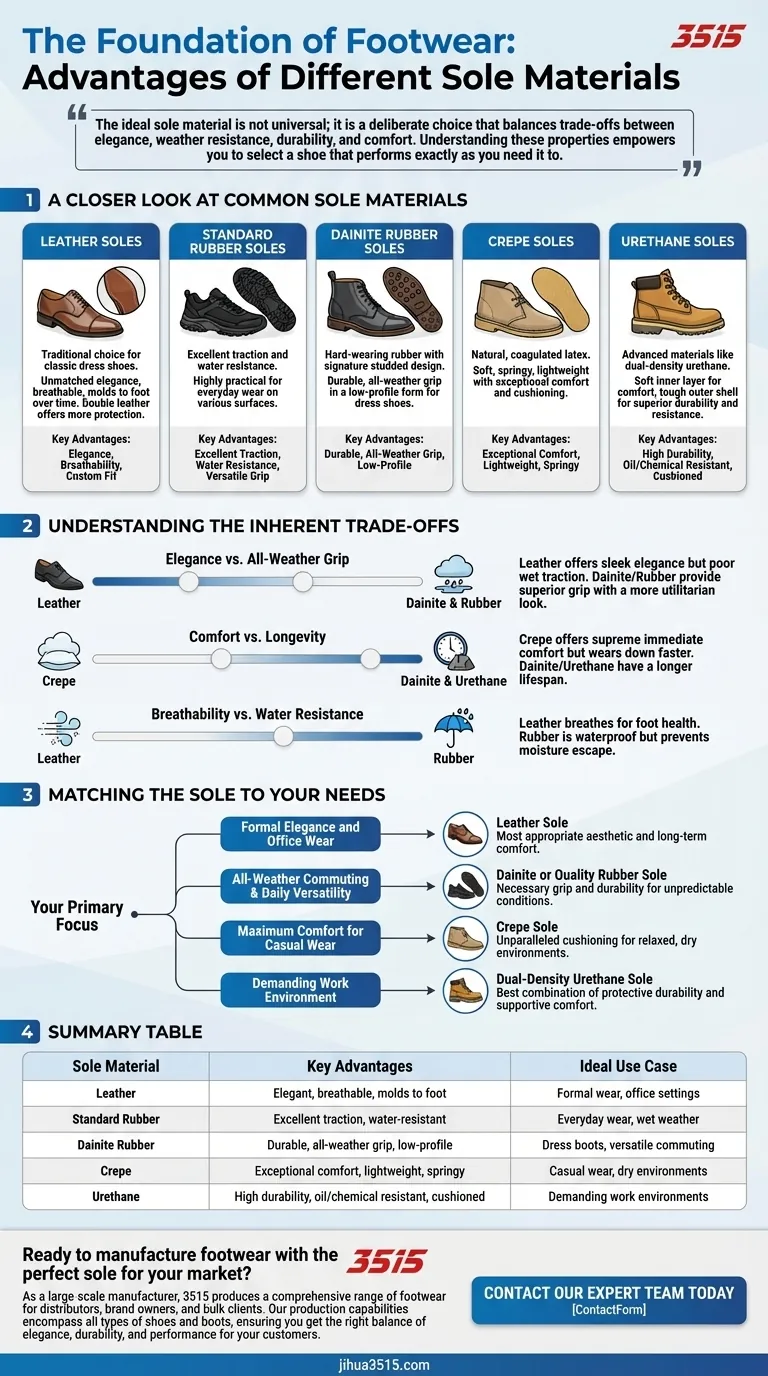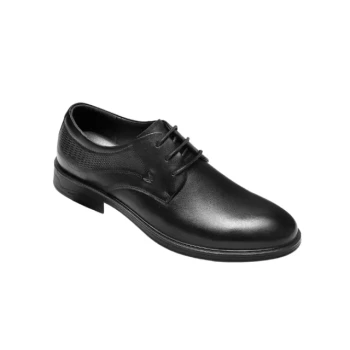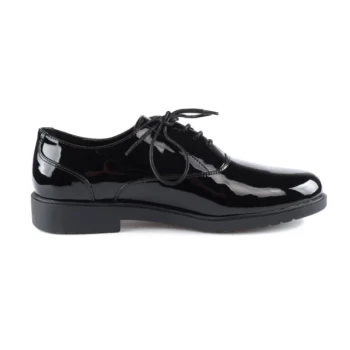Choosing the right footwear is fundamentally about understanding its foundation: the sole. The material used for the sole dictates the shoe's grip, durability, comfort, and suitability for different environments, making it the single most critical performance component.
The ideal sole material is not universal; it is a deliberate choice that balances trade-offs between elegance, weather resistance, durability, and comfort. Understanding these properties empowers you to select a shoe that performs exactly as you need it to.

A Closer Look at Common Sole Materials
Each material offers a distinct set of characteristics. The choice depends entirely on the intended function of the shoe, from the boardroom to the worksite.
Leather Soles
A leather sole is the traditional choice for classic dress shoes. Its primary advantage is its unmatched elegance and its ability to breathe, which helps regulate temperature and moisture.
Over time, a leather sole will mold to the shape of your foot, creating a custom-like fit. For added resilience, a double leather sole offers more protection and longevity, suitable for harsher city conditions.
Standard Rubber Soles
Rubber soles are prized for their excellent traction and water resistance, making them a highly practical choice for everyday wear.
They provide a secure grip on a variety of surfaces, especially in wet weather where leather would be dangerously slick. This versatility makes rubber a common feature on everything from casual sneakers to sturdy boots.
Dainite Rubber Soles
Dainite is a specific type of hard-wearing rubber sole, distinguished by its signature studded design. It offers the durability and all-weather grip of rubber but in a more streamlined, low-profile form.
This makes it an ideal compromise for dress shoes and boots, providing reliable traction in inclement weather without the bulky appearance of a heavy lug sole.
Crepe Soles
Crepe soles are made from a natural, coagulated latex that results in a soft, springy, and lightweight material. Their main advantage is exceptional comfort and cushioning right out of the box.
The unique, crinkled texture provides good grip on dry surfaces, making crepe a popular choice for casual shoes like desert boots and chukkas.
Urethane Soles
Modern footwear often uses advanced materials like dual-density urethane. These soles are engineered for specific, high-performance applications.
They typically feature a softer inner layer for cushioning and comfort, combined with a tough, dense outer layer. This outer shell provides superior durability and resistance to abrasion, cuts, oil, and chemicals.
Understanding the Inherent Trade-offs
Selecting a sole material is always an exercise in balancing competing priorities. There is no single material that excels in every category.
Elegance vs. All-Weather Grip
The sleek, classic profile of a leather sole is unparalleled for formal settings. However, it offers very poor traction in wet conditions. Dainite and rubber soles provide superior grip but have a more casual, utilitarian appearance.
Comfort vs. Longevity
Crepe soles offer supreme, immediate comfort due to their natural softness and bounce. This comfort comes at the cost of durability, as they tend to wear down much faster than other materials. Hard-wearing Dainite and urethane soles offer a much longer lifespan but may require a break-in period.
Breathability vs. Water Resistance
Leather is a natural material that breathes, which is a significant advantage for foot health and comfort during long days of wear. In contrast, rubber is non-porous. While this makes it completely waterproof, it also prevents moisture from escaping, reducing breathability.
Matching the Sole to Your Needs
Your primary use case should be the deciding factor. Use this guide to make a clear choice.
- If your primary focus is formal elegance and office wear: A leather sole offers the most appropriate aesthetic and long-term comfort.
- If your primary focus is all-weather commuting and daily versatility: A Dainite or quality rubber sole provides the necessary grip and durability for unpredictable conditions.
- If your primary focus is maximum comfort for casual wear: A crepe sole delivers unparalleled cushioning for relaxed, dry environments.
- If your primary focus is a demanding work environment: A dual-density urethane sole offers the best combination of protective durability and supportive comfort.
By aligning the material's properties with your specific goal, you ensure your footwear will serve you effectively.
Summary Table:
| Sole Material | Key Advantages | Ideal Use Case |
|---|---|---|
| Leather | Elegant, breathable, molds to foot | Formal wear, office settings |
| Standard Rubber | Excellent traction, water-resistant | Everyday wear, wet weather |
| Dainite Rubber | Durable, all-weather grip, low-profile | Dress boots, versatile commuting |
| Crepe | Exceptional comfort, lightweight, springy | Casual wear, dry environments |
| Urethane | High durability, oil/chemical resistant, cushioned | Demanding work environments |
Ready to manufacture footwear with the perfect sole for your market?
As a large-scale manufacturer, 3515 produces a comprehensive range of footwear for distributors, brand owners, and bulk clients. Our production capabilities encompass all types of shoes and boots, ensuring you get the right balance of elegance, durability, and performance for your customers.
Contact our expert team today to discuss your specific sole material requirements and volume production needs.
Visual Guide

Related Products
- Wholesale Leather Ankle Boots with Lug Soles for Custom Brand Manufacturing
- Factory Direct Wholesale Leather Comfort Shoes with Dial Closure
- Wholesale Comfort Leather Business Shoes with Dial Lacing System
- Wholesale Leather Business Casual Shoes with Dial Closure - Manufacturer of Comfort Dress Sneakers
- Wholesale Leather Work Boots with Customizable Wedge Sole for Brands
People Also Ask
- Why are high quality leather linings important for boots? Enhance Comfort, Durability & Foot Health
- Is heavy, stiff footwear necessary for good ankle support? The Truth About Boot Design & Injury Prevention
- Is it acceptable to wear dress shoes with casual outfits? Elevate Your Smart Casual Office Style
- How should dress shoes be maintained to prolong their lifespan? A Guide to Lasting Quality
- What are the benefits of classic black lace moc toe shoes? Achieve Polished, Versatile Style



















